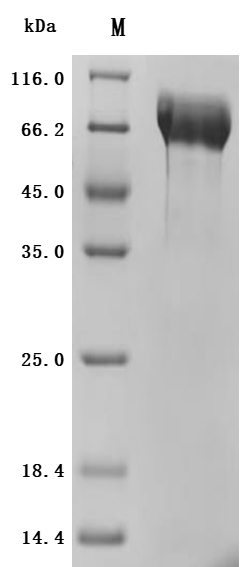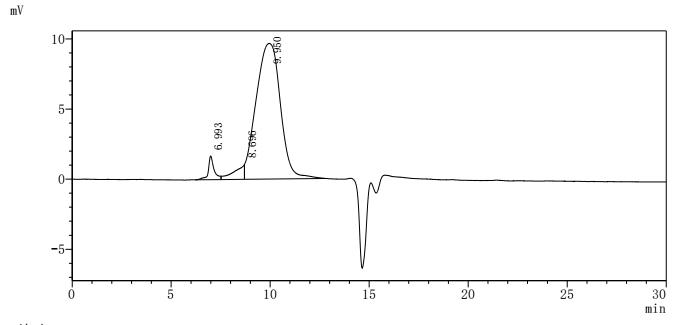This recombinant human MUC13 protein is a biologically active construct expressed in mammalian cells to ensure accurate folding and appropriate post-translational modifications. It includes amino acids 19 to 421 of the human MUC13 sequence and is engineered with a C-terminal 10xHis tag for efficient purification and detection. Provided as a lyophilized powder, the recombinant MUC13 protein meets high-quality standards, showing over 95% purity by SDS-PAGE and above 90% by SEC-HPLC. Endotoxin levels are strictly controlled and maintained below 1.0 EU/μg, as assessed by the LAL assay. Functional validation in ELISA confirms its ability to specifically bind the anti-MUC13 recombinant antibody (CSB-RA887973MA1HU) when immobilized at 2 μg/mL, with an EC50 ranging from 3.806 to 5.269 ng/mL. These characteristics make it a reliable tool for studies involving MUC13-related signaling and therapeutic antibody evaluation.
MUC13 is a transmembrane glycoprotein belonging to the mucin family that plays a significant role in various physiological and pathological processes, particularly in cancer and inflammation. Its expression and functional mechanisms have garnered attention due to its involvement in tumorigenic signaling pathways and its protective role in inflammation.
One of the critical functions of MUC13 is its role in enhancing cell signaling pathways associated with tumorigenesis. MUC13 has been implicated in stabilizing and increasing the activation of the HER2 receptor, a well-known driver of cancer progression, particularly in pancreatic and gastric cancers [1][2]. This interaction promotes downstream signaling cascades that lead to increased cell proliferation, survival, and metastasis [1][3][4]. Studies indicate that MUC13 directly binds to the EGF-like domains of HER2, leading to its phosphorylation and subsequent activation of various oncogenic pathways, including those mediated by Akt and ERK [1][2][3].
In addition to its oncogenic roles, MUC13 modulates the immune response within epithelial tissues. It has been found to protect against inflammation by inhibiting epithelial cell apoptosis and supporting mucosal integrity [5][6]. This protective functionality is particularly evident in gastrointestinal contexts, where MUC13 expression has been associated with defense mechanisms against pathogens such as Helicobacter pylori and enterotoxigenic Escherichia coli [7][8]. Moreover, MUC13 has been suggested to act as a decoy for pathogens, thereby preventing their attachment to epithelial cells [8][7].
MUC13's structural properties also enhance its functional versatility. Its cytoplasmic domain harbors potential phosphorylation sites that may contribute to its involvement in intracellular signaling, notably via pathways like NF-κB [9][6]. This phosphorylation capability suggests that MUC13 could influence not just tumor biology but also cellular responses to environmental stressors and inflammatory signals [4][2]. Furthermore, aberrations in MUC13 expression have been linked with various epithelial cancers, indicating its potential as a prognostic marker and therapeutic target [2][10][11]. Its expression is frequently upregulated in colorectal, gastric, and ovarian cancers, which highlights its significance in cancer biology beyond mere expression levels [2][10].
References:
[1] S. Khan, M. Sikander, et al. Muc13 interaction with receptor tyrosine kinase her2 drives pancreatic ductal adenocarcinoma progression. Oncogene, vol. 36, no. 4, p. 491-500, 2016. https://doi.org/10.1038/onc.2016.218
[2] L. He, L. Qu, L. Wei, Y. Chen, & J. Suo. Reduction of mir-132-3p contributes to gastric cancer proliferation by targeting muc13. Molecular Medicine Reports, vol. 15, no. 5, p. 3055-3061, 2017. https://doi.org/10.3892/mmr.2017.6347
[3] S. Chauhan, M. Ebeling, et al. Muc13 mucin augments pancreatic tumorigenesis. Molecular Cancer Therapeutics, vol. 11, no. 1, p. 24-33, 2012. https://doi.org/10.1158/1535-7163.mct-11-0598
[4] Z. Xu, Y. Liu, et al. High expression of mucin13 associates with grimmer postoperative prognosis of patients with non-metastatic clear-cell renal cell carcinoma. Oncotarget, vol. 8, no. 5, p. 7548-7558, 2016. https://doi.org/10.18632/oncotarget.13692
[5] J. Ren, X. Yan, H. Ai, Z. Zhang, X. Huang, J. Ouyanget al. Susceptibility towards enterotoxigenic escherichia coli f4ac diarrhea is governed by the muc13 gene in pigs. Plos One, vol. 7, no. 9, p. e44573, 2012. https://doi.org/10.1371/journal.pone.0044573
[6] D. Maher, B. Gupta, S. Nagata, M. Jaggi, & S. Chauhan. Mucin 13: structure, function, and potential roles in cancer pathogenesis. Molecular Cancer Research, vol. 9, no. 5, p. 531-537, 2011. https://doi.org/10.1158/1541-7786.mcr-10-0443
[7] G. LaMonte, P. Orjuela-Sánchez, et al. Dual rna-seq identifies human mucosal immunity protein mucin-13 as a hallmark of plasmodium exoerythrocytic infection. Nature Communications, vol. 10, no. 1, 2019. https://doi.org/10.1038/s41467-019-08349-0
[8] E. Layunta, S. Jäverfelt, F. Koolwijk, M. Sivertsson, B. Dolan, L. Arikeet al. Muc17 is an essential small intestinal glycocalyx component that is disrupted in crohn’s disease. Jci Insight, vol. 10, no. 3, 2024. https://doi.org/10.1172/jci.insight.181481
[9] Y. Sheng, Y. He, et al. Muc13 protects colorectal cancer cells from death by activating the nf-κb pathway and is a potential therapeutic target. Oncogene, vol. 36, no. 5, p. 700-713, 2016. https://doi.org/10.1038/onc.2016.241
[10] K. Doxtater, M. Tripathi, et al. Muc13 drives cancer aggressiveness and metastasis through the yap1-dependent pathway. Life Science Alliance, vol. 6, no. 12, p. e202301975, 2023. https://doi.org/10.26508/lsa.202301975
[11] Y. Suh, H. Lee, et al. The combined expression of metaplasia biomarkers predicts the prognosis of gastric cancer. Annals of Surgical Oncology, vol. 19, no. 4, p. 1240-1249, 2011. https://doi.org/10.1245/s10434-011-2125-1









